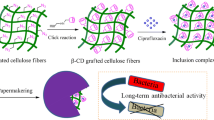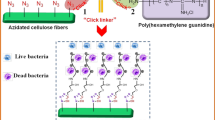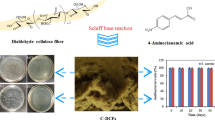Abstract
An efficient and simple way to generate “clickable” cellulose modules called alkyne-functionalized cellulose fibers (ACFs) for click reaction was presented. This method is only based on one step reaction: propargyl methacrylate (PMA) with pendant alkynyl groups was grafted onto the surface of cellulose fibers (CFs) using ceric ammonium nitrate as the initiator in aqueous medium. This has been providing a new and versatile platform for the wide utilization of cellulose resources and creation of novel functional materials. The effect of process variables on grafting copolymerization of PMA was investigated and suitable preparation conditions were identified. The clickability of ACFs was evaluated by reacting with two azides. The antibacterial cellulose functional material was achieved through incorporation of a “clickable” handle (alkynyl groups) to cellulose fibers followed by rapid attachment of β-cyclodextrin with an azide tag using copper-catalyzed click reaction and loading with ciprofloxacin hydrochloride (CipHCl). Pure CFs and ACFs showed a little affinity to CipHCl, whereas click products (ACFs@Azide-β-CD) increased the loading amount dramatically because the equilibrium amount was higher than pure CFs and ACFs. Meanwhile, the release process of CipHCl from ACFs@Azide-β-CD was prolonged to reaches the equilibrium. The ACFs@Azide-β-CD loaded with CipHCl showed excellent antibacterial activity against Escherichia coli. The ACFs@Azide-β-CD loading CipHCl have considerably longer bacterial activity against E. coli compared to CFs and ACFs.
Graphical abstract











Similar content being viewed by others
References
Abdel-Halim ES, Al-Deyab SS, Alfaifi AY (2014) Cotton fabric finished with beta-cyclodextrin: inclusion ability toward antimicrobial agent. Carbohydr Polym 102:550–556
Bao H, Li L, Gan LH, Ping Y, Li J, Ravi P (2010) Thermo- and pH-responsive association behavior of dual hydrophilic graft chitosan terpolymer synthesized via ATRP and click chemistry. Macromolecules 43(13):5679–5687
Bock VD, Hiemstra H, van Maarseveen JH (2006) CuI-catalyzed clkyne-azide “click” cycloadditions from a mechanistic and synthetic perspective. Eur J Org Chem 1:51–68
Cai T, Neoh KG, Kang ET (2011) Poly(vinylidene fluoride) graft copolymer membranes with “clickable” surfaces and their functionalization. Macromolecules 44(11):4258–4268
Carpenter BL, Scholle F, Sadeghifar H, Francis AJ, Boltersdorf J, Weare WW, Argyropoulos DS, Maggard PA, Ghiladi RA (2015) Synthesis, characterization, and antimicrobial efficacy of photomicrobicidal cellulose paper. Biomacromolecules 16(8):2482–2492
Cheng JH, Hu YN, Luo ZG, Chen W, Chen HM, Peng XC (2017) Preparation and properties of octenyl succinate beta-cyclodextrin and its application as an emulsion stabilizer. Food Chem 218:116–121
Ding C, Sun L, Xiao G, Qian X, An X (2017) Green and combinational method towards clickable alkynylated cellulose fibers (ACFs). Cellulose 24(8):3219–3229
Dong C, Ye Y, Qian L, Zhao G, He B, Xiao H (2014) Antibacterial modification of cellulose fibers by grafting β-cyclodextrin and inclusion with ciprofloxacin. Cellulose 21(3):1921–1932
Elchinger P-H, Montplaisir D, Zerrouki R (2012) Starch–cellulose crosslinking-towards a new material. Carbohydr Polym 87(2):1886–1890
Elchinger P-H, Awada H, Zerrouki C, Montplaisir D, Zerrouki R (2014) Kraft pulp-starch covalent linking: a promising route to a newmaterial. Ind Eng Chem Res 53(18):7604–7610
Fallah Z, Nasr Isfahani H, Tajbakhsh M, Tashakkorian H, Amouei A (2017) TiO2-grafted cellulose via click reaction: an efficient heavy metal ions bioadsorbent from aqueous solutions. Cellulose 25(1):639–660
Faugeras P-A, Elchinger P-H, Brouillette F, Montplaisir D, Zerrouki R (2012) Advances in cellulose chemistry-microwave-assisted synthesis of propargylcellulose in aqueous medium. Green Chem 14(3):598–600
Feese E, Sadeghifar H, Gracz HS, Argyropoulos DS, Ghiladi RA (2011) Photobactericidal porphyrin-cellulose nanocrystals: synthesis, characterization, and antimicrobial properties. Biomacromolecules 12(10):3528–3539
Fenn D, Pohl M, Heinze T (2009) Novel 3-O-propargyl cellulose as a precursor for regioselective functionalization of cellulose. React Funct Polym 69(6):347–352
Filpponen I, Argyropoulos DS (2010) Regular linking of cellulose nanocrystals via click chemistry: synthesis and formation of cellulose nanoplatelet gels. Biomacromolecules 11(4):1060–1066
Filpponen I, Kontturi E, Nummelin S, Rosilo H, Kolehmainen E, Ikkala O, Laine J (2012) Generic method for modular surface modification of cellulosic materials in aqueous medium by sequential “click” reaction and adsorption. Biomacromolecules 13(3):736–742
Gandini A, Pasquini D (2012) The impact of cellulose fibre surface modification on some physico-chemical properties of the ensuing papers. Ind Crop Prod 35(1):15–21
Hafrén J, Zou W, Córdova A (2006) Heterogeneous ‘organoclick’ derivatization of polysaccharides. Macromol Rapid Commun 27(16):1362–1366
Hosseinzadeh H (2009) Ceric-initiated free radical graft copolymerization of acrylonitrile onto kappa carrageenan. J Appl Polym Sci 114(1):404–412
Hu L, Zhao P, Deng H, Xiao L, Qin C, Du Y, Shi X (2014) Electrical signal guided click coating of chitosan hydrogel on conductive surface. RSC Adv 4(26):13477–13480
Junka K, Filpponen I, Johansson LS, Kontturi E, Rojas OJ, Laine J (2014) A method for the heterogeneous modification of nanofibrillar cellulose in aqueous media. Carbohydr Polym 100:107–115
Kabiri R, Namazi H (2014) Surface grafting of reduced graphene oxide using nanocrystalline cellulose via click reaction. J Nanopart Res 16(7):1–13
Kaur I, Kumar R, Sharma N (2010) A comparative study on the graft copolymerization of acrylic acid onto rayon fibre by a ceric ion redox system and a gamma-radiation method. Carbohydr Res 345(15):2164–2173
Khan AM, Shah SS (2009) pH Induced partitioning and interactions of ciprofloxacin hydrochloride with anionic surfactant sodium dodecyl sulfate using ultraviolet and fourier transformed infrared spectroscopy study. J Dispers Sci Technol 30(9):1247–1254
Kolářová K, Vosmanská V, Rimpelová S, Švorčík V (2013) Effect of plasma treatment on cellulose fiber. Cellulose 20(2):953–961
Kolb HC, Finn MG, Sharpless KB (2001) Click chemistry: bdiverse chemical function from a few good reactions. Angew Chem 40:2004–2021
Kumar V, Naithani S, Pandey D (2011) Optimization of reaction conditions for grafting of α-cellulose isolated from Lantana camara with acrylamide. Carbohydr Polym 86(2):760–768
Kumar R, Sharma RK, Singh AP (2017) Cellulose based grafted biosorbents-journey from lignocellulose biomass to toxic metal ions sorption applications—a review. J Mol Liq 232:62–93
Lee MH, Yoon KJ, Ko S (2015) Grafting onto cotton fiber with acrylamidomethylated β-cyclodextrin and its application. J Appl Polym Sci 78(11):1986–1991
Mangiante G, Alcouffe P, Burdin B, Gaborieau M, Zeno E, Petit-Conil M, Bernard J, Charlot A, Fleury E (2013) Green nondegrading approach to alkyne-functionalized cellulose fibers and biohybrids thereof: synthesis and mapping of the derivatization. Biomacromolecules 14(1):254–263
Meng X, Edgar KJ (2016) “Click” reactions in polysaccharide modification. Prog Polym Sci 53:52–85
Nongbe MC, Bretel G, Ekou L, Ekou T, Robitzer M, Le Grognec E, Felpin F-X (2018) Cellulose paper azide as a molecular platform for versatile click ligations: application to the preparation of hydrophobic paper surface. Cellulose 25(2):1395–1411
Orelma H, Teerinen T, Johansson LS, Holappa S, Laine J (2012) CMC-modified cellulose biointerface for antibody conjugation. Biomacromolecules 13(4):1051–1058
Parsamanesh M, Dadkhah Tehrani A (2016) Synthesize of new fluorescent polymeric nanoparticle using modified cellulose nanowhisker through click reaction. Carbohydr Polym 136:1323–1331
Pohl M, Morris GA, Harding SE, Heinze T (2009) Studies on the molecular flexibility of novel dendronized carboxymethyl cellulose derivatives. Eur Polym J 45(4):1098–1110
Sadeghifar H, Venditti R, Jur J, Gorga RE, Pawlak JJ (2016) Cellulose–lignin biodegradable and flexible UV protection film. ACS Sustain Chem Eng 5(1):625–631
Singha AS, Rana AK (2011) Kinetics of graft copolymerization of acrylic acid onto cannabis indica fibre. Iran Polym J 20(11):913–929
Sobocinski J, Laure W, Taha M, Courcot E, Chai F, Simon N, Addad A, Martel B, Haulon S, Woisel P, Blanchemain N, Lyskawa J (2014) Mussel inspired coating of a biocompatible cyclodextrin based polymer onto CoCr vascular stents. ACS Appl Mater Interfaces 6(5):3575–3586
Sun L, Qian X, Ding C, An X (2018) Integration of graft copolymerization and ring-opening reaction: a mild and effective preparation strategy for “clickable” cellulose fibers. Carbohydr Polym 198:41–50
Tungala K, Adhikary P, Krishnamoorthi S (2013) Trimerization of beta-cyclodextrin through the click reaction. Carbohydr Polym 95(1):295–298
Tyagi C, Tomar LK, Singh H (2009) Surface modification of cellulose filter paper by glycidyl methacrylate grafting for biomolecule immobilization: influence of grafting parameters and urease immobilization. J Appl Polym Sci 111(3):1381–1390
Wang J-h, Cai Z (2008) Incorporation of the antibacterial agent, miconazole nitrate into a cellulosic fabric grafted with β-cyclodextrin. Carbohydr Polym 72(4):695–700
Wang C, Fan Y, Hu MX, Xu W, Wu J, Ren PF, Xu ZK (2013) Glycosylation of the polypropylene membrane surface via thiol-yne click chemistry for lectin adsorption. Colloids Surf B 110:105–112
Wiarachai O, Vilaivan T, Iwasaki Y, Hoven VP (2016) Clickable and antifouling platform of poly[(propargyl methacrylate)-ran-(2-methacryloyloxyethyl phosphorylcholine)] for biosensing applications. Langmuir 32(4):1184–1194
Xiao G, Ding C, Song F, Qian X, An X (2016) Facile strategy for preparation of alkyne-functionalized cellulose fibers with click reactivity. Cellulose 24(2):591–607
Yang WJ, Pranantyo D, Neoh KG, Kang ET, Teo SL, Rittschof D (2012) Layer-by-layer click deposition of functional polymer coatings for combating marine biofouling. Biomacromolecules 13(9):2769–2780
Yuan W, Li X, Gu S, Cao A, Ren J (2011) Amphiphilic chitosan graft copolymer via combination of ROP, ATRP and click chemistry: synthesis, self-assembly, thermosensitivity, fluorescence, and controlled drug release. Polymer 52(3):658–666
Zhang J, Xu X-D, Wu D-Q, Zhang X-Z, Zhuo R-X (2009) Synthesis of thermosensitive P(NIPAAm-co-HEMA)/cellulose hydrogels via “click” chemistry. Carbohydr Polym 77(3):583–589
Zhang L, Zhou J, Zhang L (2013) Structure and properties of beta-cyclodextrin/cellulose hydrogels prepared in NaOH/urea aqueous solution. Carbohydr Polym 94(1):386–393
Zhang Y, Li L, Zhang L, Ge S, Yan M, Yu J (2017) In-situ synthesized polypyrrole-cellulose conductive networks for potential-tunable foldable power paper. Nano Energy 31:174–182
Zhao F, Repo E, Yin D, Meng Y, Jafari S, Sillanpaa M (2015) EDTA-cross-linked beta-cyclodextrin: an environmentally friendly bifunctional adsorbent for simultaneous adsorption of metals and cationic dyes. Environ Sci Technol 49(17):10570–10580
Acknowledgments
The authors gratefully acknowledge the National Natural Science Foundation of China (Grant No. 31370579) for financial support to this work.
Author information
Authors and Affiliations
Corresponding author
Additional information
Publisher's Note
Springer Nature remains neutral with regard to jurisdictional claims in published maps and institutional affiliations.
Rights and permissions
About this article
Cite this article
Sun, L., Ding, C., Qian, X. et al. Effective and simple one-step strategy for preparation of “clickable” cellulose modules: support to build antibacterial materials. Cellulose 26, 1961–1976 (2019). https://doi.org/10.1007/s10570-018-2215-3
Received:
Accepted:
Published:
Issue Date:
DOI: https://doi.org/10.1007/s10570-018-2215-3




